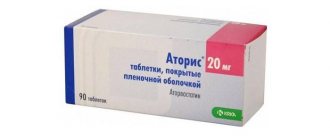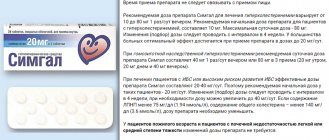Release form and composition
Dosage form – film-coated tablets: 10 mg – white or almost white film coat, engraved “HLA 10” on one side, 20 mg – light yellow film coat, engraved “HLA 20” on one side, 40 mg – white film shell with a yellowish-brown tint, engraved “HLA 40” on one side; The tablets are biconvex, round, white when cut (10 pieces in blisters, 3, 6, 9 blisters in a cardboard pack).
Composition of 1 tablet:
- active ingredient: atorvastatin (in the form of atorvastatin calcium) – 10, 20 or 40 mg;
- auxiliary components: croscarmellose sodium, lactose monohydrate, polysorbate 80, hyprolose, colloidal silicon dioxide, magnesium stearate, heavy magnesium oxide, microcrystalline cellulose;
- film coating: hyprolose, hypromellose, macrogol 6000, talc, titanium dioxide, for a dose of 20 and 40 mg additionally - yellow iron oxide.
Tulip
Active substance:
Atorvastatin*
Pharmgroup:
Statins
Average price in pharmacies
| Name | Manufacturer | average price |
| Tulip 0.01 n30 tablet p/film/sheath | SANDOZ | 248.00 |
| Tulip 0.01 n90 tablet p/film/sheath | SANDOZ | 683.00 |
| Tulip 0.02 n90 tablet p/film/sheath | SANDOZ | 1006.00 |
| Tulip 0.04 n30 tablet p/film/sheath | SANDOZ | 654.00 |
Analogs for the active substance:Anvistat Atomax Atorvastatin calcium Atorvastatin calcium crystalline Atorvastatin-OBL Atorvastatin-LEKSVM Atorvastatin-Tabuk Atorvastatin-Teva Atorvox Atoris Vasator Lipona Lipoford Liprimar Liptonorm TG-tor Torvazin Torvacard | Application area:Secondary hyperlipoproteinemia Heterozygous hereditary hypercholesterolemia Heterozygous nonfamilial hypercholesterolemia Heterozygous familial hypercholesterolemia Hyperlipidemia Hyperlipidemia type II Hyperlipidemia IIa Hyperlipidemia type IIa Hyperlipoproteinemia Hyperlipoproteinemia type IIa Hyperlipoproteinemia type IIb Hypercholesterolemia Primary hypercholesterolemia Homozygous familial hypercholesterolemia Homozygous sitosterolemia Isolated endogenous hypercholesterolemia Combined hyperlipidemia Combined hypercholesterolemia and hypertriglyceridemia Combined hypercholesterolemia and hypertriglyceridemia Combined hypercholesterolemia and triglyceridemia Correction of lipid metabolism disorders Primary hypercholesterolemia Elevated LDL level Elevated cholesterol levels Increased blood cholesterol levels Familial hypercholesterolemia Mixed familial hypercholesterolemia Phytosterolemia Endogenous hypercholesterolemia |
Indications for use
- primary hypercholesterolemia, heterozygous familial and non-familial hypercholesterolemia and combined (mixed) hyperlipidemia type IIa and IIb according to the Fredrickson classification - Tulip is used in combination with a hypocholesterolemic diet to reduce elevated concentrations of total cholesterol (C), low-density lipoprotein cholesterol (LDL-C), apolipoprotein B (apoB), thyroglobulin (TG) and increased concentrations of high-density lipoprotein cholesterol (HDL-C), when diet therapy and other non-drug methods alone have insufficient effect;
- homozygous familial hypercholesterolemia - to reduce elevated concentrations of LDL cholesterol and total cholesterol, when diet therapy and other non-drug methods alone are not effective enough;
- cardiovascular complications in patients without clinical signs of coronary heart disease (CHD), but in the presence of some risk factors for its development, such as nicotine dependence, arterial hypertension, retinopathy, diabetes mellitus, albuminuria, low plasma concentrations of HDL-C, genetic predisposition, including against the background of dyslipidemia, age over 55 years - for primary prevention;
- cardiovascular complications in patients with coronary artery disease - secondary prevention of the condition to reduce the total rate of mortality, stroke, myocardial infarction, readmission for angina and the need for revascularization.
Pharmacokinetics
Absorption of the drug Tulip is quite high and reaches a maximum in plasma blood within 1 - 2 hours after using the tablets.
The concentration of the atorvastatin component in the female body is 20.0% higher than in the male body, and the AUC is 10.0% lower than in the male body.
In case of cirrhosis of liver cells caused by alcohol intake, the concentration is 16-18 times higher, and AUC is 11 times higher than normal.
Eating reduces the rate of absorption of Tulip, but the degree of exposure to the active component in the drug does not affect the decrease in the total index of cholesterol in the blood and low molecular density lipoproteins.
If you take Tulip in the evening, then the plasma concentration of the drug component atorvastatin is lower than its concentration in the morning. The discrepancy is approximately 30.0%.
The reduction in total cholesterol and low molecular density lipoproteins is not affected by the time of taking the drug.
The rate of absorption of the drug depends on the dosage taken.
The bioavailability of the drug Tulip is 14.0%, the bioavailability in the bloodstream and its activity in relation to the suppression of reductase is within 30.0%.
The low percentage of bioavailability depends on the metabolism of the digestive tract, and on the activity of the liver cells through which the drug passes before entering the system.
Plasma protein binding Tulip - 98.0%. The concentration of the active component of the drug in erythrocytes is no more than 0.250, which means insufficient penetration of the atorvastatin component into the erythrocyte molecules.
Metabolism of Tulip occurs in liver cells in the CYP3A4 and CYP3A5 isoenzymes, as well as the CYP3A7 isoenzyme, which affects the formation of active metabolite molecules that inhibit the HMG-CoA reductase enzyme.
Reductase inhibitory property within 70.0%. The time period of exposure to the reductase enzyme is from 20 hours to 30 hours.
Atorvastatin does not have an active effect on the inhibition of CYP3A4 molecules.
The drug Tulip leaves the body through the intestines. The transit time through the body from the moment of ingestion to the moment of release is about 14 hours.
The bioavailability of the drug Tulip is 14.0%, the bioavailability in the bloodstream and its activity in relation to the suppression of reductase is within 30.0%.
Up to 2.0% of the taken dosage of the drug is diagnosed in urine.
The drug is not removed from the body using hemodialysis, and the condition of the cells of the kidney organ does not affect the cholesterol-lowering properties of the drug.
Contraindications
Absolute contraindications:
- liver damage in the active phase;
- an increase in the blood plasma activity of hepatic transaminases of unknown origin in comparison with the upper limit of normal (ULN) by more than 3 times;
- glucose-galactose malabsorption syndrome, lactose intolerance, lactase deficiency (contains lactose);
- pregnancy and breastfeeding (lactation);
- children and adolescents under 18 years of age (the effectiveness and safety of taking atorvastatin in this age category of patients has not been established);
- increased individual sensitivity to the components of the drug.
Tulip is used with caution in cases of severe electrolyte imbalance, a history of liver disease, alcohol abuse, diseases of the muscular system and a history of muscle pathologies due to the use of other drugs from the group of HMG-CoA reductase inhibitors, metabolic and endocrine (hyperthyroidism). ) disorders, arterial hypotension, diabetes mellitus, severe acute infections (sepsis), uncontrolled epilepsy, major surgery, trauma, aggressive lipid-lowering therapy (atorvastatin 80 mg) for secondary prevention of stroke in patients with a history of hemorrhagic or lacunar stroke.
Analogs
Tulip has a sufficient number of analogues, where the active ingredient is atorvastatin. The drugs are not intended as self-medication, or as an independent replacement of a prescribed statin with its analogue.
Only the doctor knows whether Atoris or Tulip is better for treating a specific pathology in a patient.
Analogues of the drug:
- The drug Atoris;
- Atorvastatin tablets;
- Medicine Torvakard;
- Medication Torvalip;
- Drug Torvas;
- Medicine Tulin.
Akorta Atomax Lipitor Owencor Pravastatin Simvastol
Directions for use and dosage
Before starting to use the drug Tulip, the patient should be recommended a standard cholesterol-lowering diet, which must be followed throughout the entire period of treatment with the drug.
The tablets are taken orally regardless of diet.
The recommended range of daily doses of the drug Tulip is 10–80 mg, a specific dose is selected based on data on the concentration of LDL-C, the purpose of treatment and the individual therapeutic response of the patient.
The initial dose in most cases is 10 mg per day, the maximum is 80 mg per day.
At the beginning of therapy, after 14–28 days and/or at each increase in the dose of the drug, plasma lipid concentrations should be monitored and, if necessary, the dose of atorvastatin should be adjusted.
Recommended dosage regimen:
- primary (heterozygous hereditary and polygenic) hypercholesterolemia (type IIa) and mixed hyperlipidemia (type IIb): a dose of 10 mg once a day is usually sufficient (tablets of 10 and 20 mg can be used); if necessary, it is permissible to gradually increase the dose to 80 mg (2 tablets of 40 mg), taking into account the patient’s response and maintaining an interval between dose increases of 14–28 days, since the therapeutic effect is noted after 14 days, and the maximum therapeutic effect is recorded after 28 days and persists with long-term treatment;
- homozygous hereditary hypercholesterolemia: 80 mg (2 tablets of 40 mg) once a day;
- cardiovascular diseases (for prevention): 10 mg 1 time per day, if the optimal plasma concentration of LDL is not achieved, it is permissible to gradually increase the dose to 80 mg (2 tablets of 40 mg), taking into account the patient’s response and maintaining an interval between dose increases of 14 –28 days.
No dose adjustment of Tulip is required for patients with renal failure and elderly patients.
In case of liver dysfunction, the elimination of atorvastatin from the body slows down, so it is recommended to use it with caution, constantly monitoring the activity of liver transaminases: aspartate aminotransferase (AST) and alanine aminotransferase (ALT).
Reviews
Oksana, 39 years old: I was prescribed Tulip when my cholesterol was 7.3 mmol per liter, but there are a lot of side effects in the beds. I have been taking this statin for 4 months. My cholesterol returned to normal, but my health did not improve.
Georgy, 58 years old: I have been diagnosed with high cholesterol for 14 years. I took various statins and fibrates.
I have diabetes, so my cholesterol keeps going up. I have been taking Tulip based on atorvastatin for 2 years.
My lipid levels are normal and I feel great. This is the first medication that does not cause adverse reactions in my body.
Side effects
- nervous system: often – headache; uncommon – sleep disturbance (including insomnia and nightmares), dizziness, asthenic syndrome, paresthesia, hypoesthesia, weakness, memory loss/decrease, impaired taste sensitivity; rarely – peripheral neuropathy;
- sense organs: infrequently – blurred vision, tinnitus; rarely - visual impairment; extremely rarely - hearing loss;
- digestive system: often - flatulence, constipation, nausea, dyspepsia, diarrhea; uncommon – vomiting, anorexia, hepatitis, pancreatitis, belching, abdominal pain; rarely – cholestatic jaundice (including obstructive); extremely rarely - liver failure;
- musculoskeletal system: often - swelling of the joints, myalgia, arthralgia, joint pain, muscle spasm, back pain; uncommon – pain in the neck muscles, myasthenia gravis; rarely - myositis, myopathy, rhabdomyolysis, tendinopathy (sometimes to tendon ruptures); unknown frequency - cases of immune-mediated necrotizing myopathy;
- skin and subcutaneous tissues: uncommon – skin rash, itching, urticaria, alopecia; rarely - bullous rash, angioedema, erythema multiforme exudative (including Stevens-Johnson syndrome) and Lyell's syndrome (toxic epidermal necrolysis);
- hematopoietic system: infrequently – thrombocytopenia;
- metabolism: often – hyperglycemia; uncommon – hypoglycemia;
- respiratory system: often – sore throat, nasopharyngitis, nosebleeds;
- immune system: often – hypersensitivity reactions; extremely rarely - anaphylaxis;
- laboratory indicators: often - increased activity of serum creatine phosphokinase (CPK), increased activity of ALT and AST; uncommon – leukocyturia; unknown frequency - increase in the concentration of glycosylated hemoglobin;
- other reactions: infrequently - increased fatigue, secondary renal failure, impaired potency, hyperthermia, peripheral edema, chest pain, weight gain; extremely rarely – diabetes mellitus, gynecomastia; there is some evidence of the development of atonic fasciitis, but the exact connection with the use of atorvastatin has not been established; unknown frequency - interstitial lung disease (especially with prolonged use), depression, sexual dysfunction.
In case of an overdose of Tulip, symptomatic therapy is necessary. Atorvastatin does not have a specific antidote, and hemodialysis is not effective due to the significant binding of the drug to plasma proteins.
special instructions
Tulip, like other statins (HMG-CoA reductase inhibitors), can increase the serum activity of the liver enzymes AST and ALT by more than 3 times compared to ULN. Therefore, it is necessary to monitor liver function indicators before taking the drug, after 6 and 12 weeks from the start of treatment and when increasing its dose. Monitoring liver function indicators is also necessary when clinical signs of liver damage appear. If the activity of AST and ALT increases, the indicators should be monitored until the values normalize; if the increase is more than 3 times higher than the ULN and persists, it is recommended to reduce the dose or stop taking the drug.
The use of Tulip may cause the development of myalgia. In patients with diffuse myalgia, muscle weakness or soreness and/or a marked increase in CPK activity, the presence of myopathy can be assumed. In this case (presence of confirmed/suspected myopathy), atorvastatin therapy should be discontinued.
Due to the increased risk of myopathy with simultaneous use of Tulip with immunosuppressants, fibrates, azole antifungals, erythromycin, nicotinic acid (in lipid-lowering doses of more than 1 g per day), treatment with the drug is started only after a thorough assessment of the ratio of the expected benefits of therapy with the likelihood of severe side effects reactions. If combination treatment is necessary, it is recommended to consider the possibility of adjusting the initial and maintenance doses of these drugs downwards.
During therapy, CPK activity and serum glucose concentrations should be periodically monitored.
Patients should be informed of the need to immediately consult a doctor if any unexplained pain and/or muscle weakness occurs, especially when accompanied by general deterioration and fever.
Rare cases of rhabdomyolysis with the development of acute renal failure caused by myoglobinuria have been described due to the use of Tulip, as well as other statins (HMG-CoA reductase inhibitors).
If signs of possible myopathy appear or if there is a risk of developing renal failure factors against the background of rhabdomyolysis (arterial hypotension, severe acute infection, trauma, major surgery, serious metabolic, endocrine and electrolyte disturbances, uncontrolled convulsions), atorvastatin should be suspended or treatment should be discontinued.
During the period of therapy with Tulip, care must be taken when driving vehicles and engaging in other potentially hazardous types of work, which require increased concentration and speed of psychomotor reactions.
conclusions
The article tells you everything patients need to know about using Tulip tablets for high cholesterol. Data from comparative studies of this medicine and the original drug atorvastatin, Liprimar, are presented. Side effects are described in detail - an issue that worries everyone. Atorvastatin lowers “bad” cholesterol in the blood more than the previous generation of statins - lovastatin and simvastatin. It not only slows down the development of atherosclerosis, but also reduces the thickness of atherosclerotic plaques. Unfortunately, there is no data on how taking inexpensive atorvastatin drugs affects atherosclerotic plaques that have already formed.
Rosuvastatin is an even newer drug than atorvastatin. Currently, the main competition among statins in the pharmaceutical market is between these drugs. Atorvastatin is not thought to increase the risk of diabetes mellitus as much as rosuvastatin. Tulip or other atorvastatin drugs may be better suited for heart failure patients. Although the manufacturers of rosuvastatin are unlikely to agree with this :). Atorvastatin appears to protect the kidneys better than rosuvastatin in patients with type 1 and type 2 diabetes. The choice of a specific drug should be made by the attending physician. Do not self-medicate.
Drug interactions
- cyclosporine, erythromycin, clarithromycin, immunosuppressive, antifungal drugs (azole derivatives): increase the risk of myopathy when used simultaneously with HMG-CoA reductase inhibitors due to a possible increase in serum concentrations of atorvastatin;
- indinavir, ritonavir (HIV protease inhibitors), fibrates and nicotinic acid (in lipid-lowering doses of more than 1 g per day): increase the risk of developing myopathy;
- inhibitors of the CYP3A4 isoenzyme (including protease inhibitors): an increase in the concentration of atorvastatin in the blood plasma is possible;
- OATP1B1 transport protein inhibitors (for example, cyclosporine): may increase the bioavailability of atorvastatin;
- erythromycin and clarithromycin: increase the concentration of atorvastatin in the blood plasma (by 40% and 56%, respectively);
- diltiazem: at a dose of 240 mg with 40 mg of atorvastatin increases the concentration of the latter in the blood plasma;
- cimetidine: no clinically significant interaction with atorvastatin has been identified;
- itraconazole: at a dose of 200 mg with 20–40 mg of atorvastatin, increases the AUC value of atorvastatin by 3 times;
- grapefruit juice: in a volume of more than 1.2 liters per day for 5 days may cause an increase in plasma concentrations of atorvastatin;
- inducers of the CYP3A4 isoenzyme (for example, efavirenz or rifampicin): may lead to a decrease in the concentration of atorvastatin in the blood plasma, since rifampicin is an inducer of the CYP3A4 isoenzyme and at the same time an inhibitor of the hepatocyte transport protein OATP1B1; due to this double interaction, it is not recommended to take it simultaneously with Tulip;
- antacids: combined oral administration of suspensions containing aluminum and magnesium hydroxides with atorvastatin reduces the plasma concentration of the latter by ~35%, but the degree of reduction in the concentration of LDL-C does not change;
- terfenadine, phenazone: atorvastatin does not affect their pharmacokinetics, so drug interactions are not expected;
- colestipol: reduces the concentration of atorvastatin by 25%, but enhances the lipid-lowering effect due to the synergistic effect;
- fusidic acid: there is data from post-marketing studies on the side effects of joint use on the functions of the muscular system, up to the destruction of muscle tissue cells (rhabdomyolysis); Close monitoring of patients and, if necessary, discontinuation of Tulip are recommended;
- colchicine: cases of myopathy have been reported (caution should be used when used together);
- digoxin: use with high doses of atorvastatin (80 mg per day) increases the plasma concentration of digoxin by ~20% (it is recommended to monitor this indicator);
- azithromycin, amlodipine: when used with atorvastatin in therapeutic doses, there is no interaction;
- oral contraceptives: when choosing oral contraceptives, it is necessary to take into account that atorvastatin significantly increases the AUC of ethinyl estradiol and norethisterone, by 20% and 30%, respectively;
- indirect coumarin anticoagulants (warfarin): simultaneous use with atorvastatin affects the anticoagulant effect (monitoring of prothrombin time is required at the beginning of joint use, when changing dosage and stopping therapy);
- other lipid-lowering drugs (gemfibrozil, ezetimibe, fibrates): taken in lipid-lowering doses increases the risk of developing rhabdomyolysis;
- antihypertensive drugs and estrogens (as replacement therapy): no clinically significant interaction was observed.




